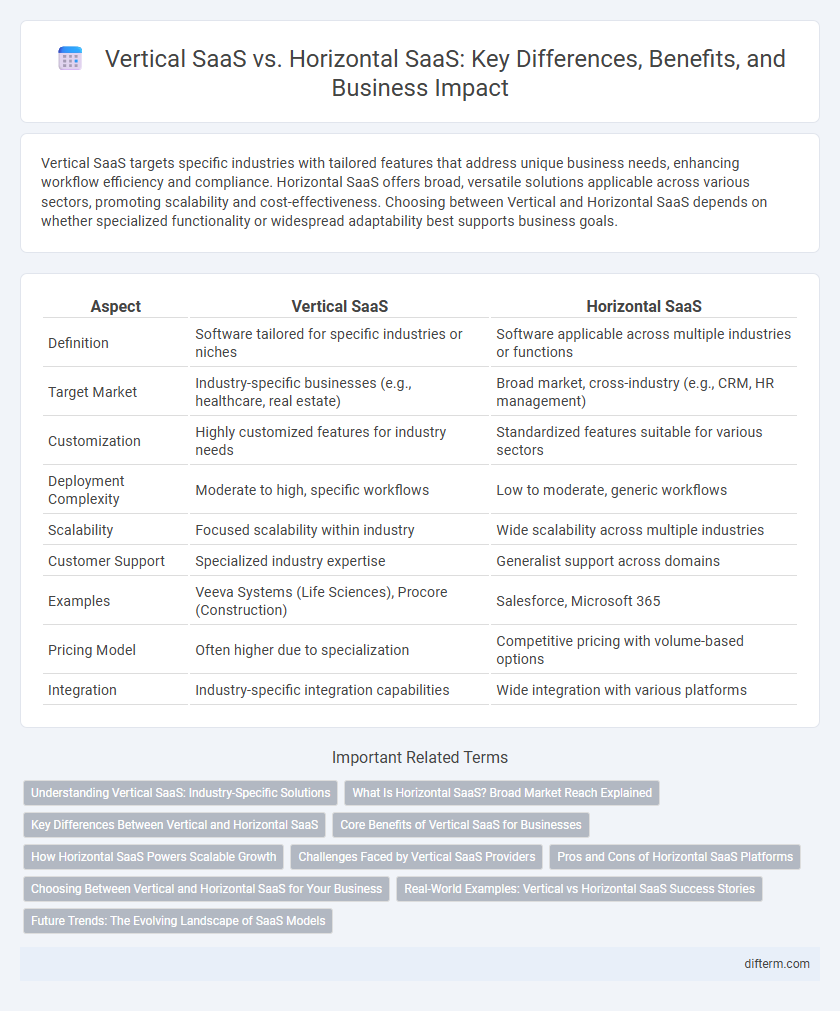Vertical SaaS targets specific industries with tailored features that address unique business needs, enhancing workflow efficiency and compliance. Horizontal SaaS offers broad, versatile solutions applicable across various sectors, promoting scalability and cost-effectiveness. Choosing between Vertical and Horizontal SaaS depends on whether specialized functionality or widespread adaptability best supports business goals.
Table of Comparison
| Aspect | Vertical SaaS | Horizontal SaaS |
|---|---|---|
| Definition | Software tailored for specific industries or niches | Software applicable across multiple industries or functions |
| Target Market | Industry-specific businesses (e.g., healthcare, real estate) | Broad market, cross-industry (e.g., CRM, HR management) |
| Customization | Highly customized features for industry needs | Standardized features suitable for various sectors |
| Deployment Complexity | Moderate to high, specific workflows | Low to moderate, generic workflows |
| Scalability | Focused scalability within industry | Wide scalability across multiple industries |
| Customer Support | Specialized industry expertise | Generalist support across domains |
| Examples | Veeva Systems (Life Sciences), Procore (Construction) | Salesforce, Microsoft 365 |
| Pricing Model | Often higher due to specialization | Competitive pricing with volume-based options |
| Integration | Industry-specific integration capabilities | Wide integration with various platforms |
Understanding Vertical SaaS: Industry-Specific Solutions
Vertical SaaS delivers tailored software solutions designed for specific industries such as healthcare, finance, or retail, addressing unique regulatory requirements and operational challenges. This industry-specific focus enables businesses to achieve higher efficiency, compliance, and customization compared to generalist Horizontal SaaS platforms. Companies leveraging Vertical SaaS benefit from deep domain expertise embedded in the software, driving better user adoption and improved business outcomes.
What Is Horizontal SaaS? Broad Market Reach Explained
Horizontal SaaS refers to software solutions designed to serve a wide range of industries and business functions, offering versatile tools like CRM, HR, or accounting systems that can be customized for diverse organizational needs. These platforms enable businesses from various sectors to streamline operations, improve productivity, and leverage scalable technology without being confined to specific industry requirements. The broad market reach of horizontal SaaS drives innovation and cost-efficiency by addressing common challenges across multiple business domains.
Key Differences Between Vertical and Horizontal SaaS
Vertical SaaS targets industry-specific solutions, offering tailored features designed for sectors like healthcare, finance, or retail, while Horizontal SaaS provides broad, general-purpose applications applicable across various industries, such as CRM or project management tools. Vertical SaaS delivers deeper domain expertise, compliance with industry regulations, and customized workflows, whereas Horizontal SaaS emphasizes scalability, broad market reach, and integration versatility. Choosing between vertical and horizontal SaaS hinges on the need for specialized functionality versus flexible, wide-ranging applications.
Core Benefits of Vertical SaaS for Businesses
Vertical SaaS delivers specialized solutions tailored to specific industries, enhancing workflow efficiency and regulatory compliance. These platforms offer deep domain expertise, enabling businesses to address unique challenges with customized features and integrations. As a result, vertical SaaS drives higher user adoption and ROI by aligning closely with industry-specific needs and processes.
How Horizontal SaaS Powers Scalable Growth
Horizontal SaaS delivers scalable growth by providing versatile software solutions that serve multiple industries, enabling businesses to expand without the constraints of niche-specific tools. Its broad applicability reduces customer acquisition costs and accelerates market penetration across diverse sectors. The ability to customize features for varied user needs fosters adaptability and long-term user retention, driving sustained revenue growth.
Challenges Faced by Vertical SaaS Providers
Vertical SaaS providers face significant challenges including the need for deep industry-specific expertise to develop tailored solutions that meet unique regulatory and operational requirements. Limited market size and higher customer acquisition costs often constrain growth compared to horizontal SaaS companies targeting broader markets. Customization demands and integration complexities also increase development timelines and require ongoing specialized support to maintain competitive advantage.
Pros and Cons of Horizontal SaaS Platforms
Horizontal SaaS platforms offer broad applicability across multiple industries, enabling businesses to benefit from scalable, versatile solutions with standardized features. They typically provide lower implementation costs and quicker deployment due to their general-purpose design, but may lack the deep customization and specialized functionality required by niche markets. The trade-off involves balancing efficiency and cost-effectiveness against limited industry-specific adaptability and potential gaps in meeting unique organizational workflows.
Choosing Between Vertical and Horizontal SaaS for Your Business
Choosing between vertical and horizontal SaaS depends on the specific industry requirements and scalability goals of your business. Vertical SaaS solutions offer tailored features for niche markets, enhancing operational efficiency and compliance in sectors like healthcare, finance, or retail. Horizontal SaaS provides broad applicability across multiple industries, ideal for companies seeking versatile tools that support a wide range of functions such as CRM, accounting, or project management.
Real-World Examples: Vertical vs Horizontal SaaS Success Stories
Vertical SaaS companies like Veeva Systems, which targets the life sciences industry, demonstrate how tailored solutions drive deep customer loyalty and higher retention rates by addressing specific regulatory and operational needs. Horizontal SaaS platforms such as Salesforce excel by offering broad applications across multiple industries, achieving scalability and extensive market penetration through customizable CRM tools. These success stories highlight the contrast between Vertical SaaS's specialized industry focus and Horizontal SaaS's wide-reaching adaptability, shaping distinct growth strategies in the software market.
Future Trends: The Evolving Landscape of SaaS Models
Vertical SaaS solutions are increasingly tailored to industry-specific needs, driving deeper integrations and enhanced customization for sectors such as healthcare, finance, and manufacturing. Horizontal SaaS platforms continue to expand their reach by incorporating AI-driven analytics and cross-industry collaboration features that cater to a broader range of business functions. Future trends indicate a blend of both models with hybrid SaaS approaches emerging, leveraging the scalability of horizontal solutions and the specificity of vertical offerings to meet evolving market demands.
Vertical SaaS vs Horizontal SaaS Infographic

 difterm.com
difterm.com